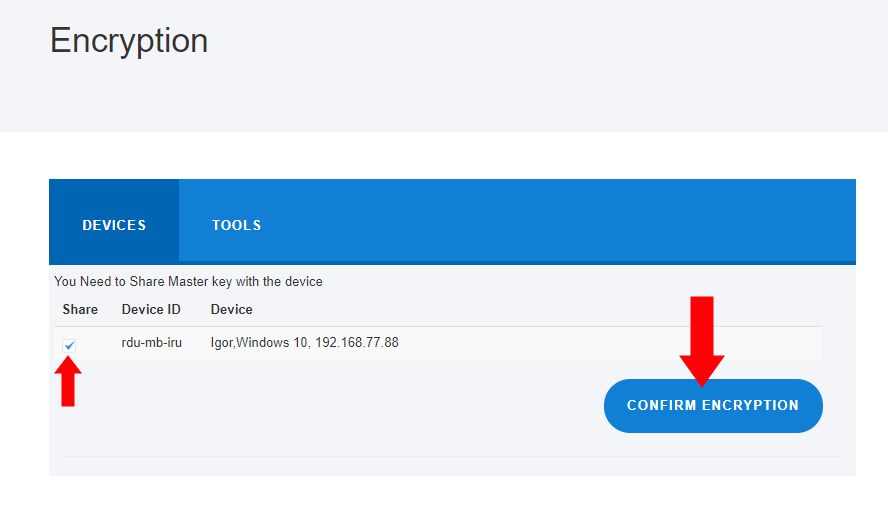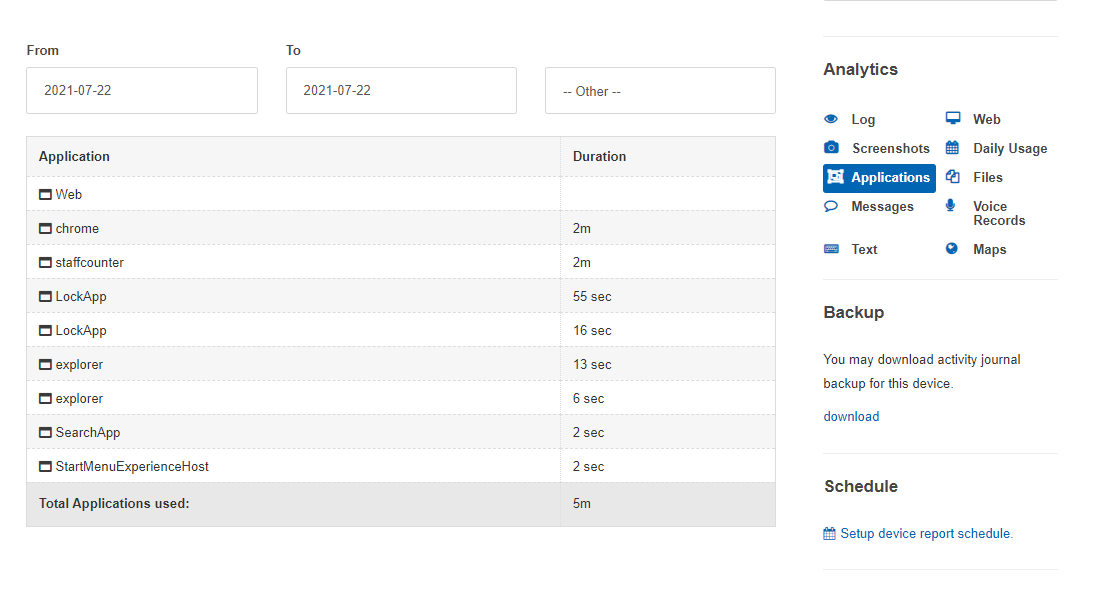Hur man aktiverar end-to-end-kryptering (E2EE)
I dag är KidLogger den första lösningen i världen som erbjuder end-to-end-kryptering (E2EE). Alla data som fångas upp från barnets datorer kommer att krypteras och avkodas endast för kontoägaren. Barnets aktivitetsdata som fångas upp från slutpunktsenheter kommer att krypteras innan de överförs till vår molntjänst. Den huvudsakliga skillnaden jämfört med SSL-kryptering är att data fortfarande är krypterade när de når KidLogger-molnlagring och vidare är de kvar i krypterad form även i alla typer av körande instanser av databasen, exekveringskontexter och bearbetningsalgoritmer inom våra molnservrar. När du loggar in på ditt konto levereras data till webbläsaren i sitt ursprungliga krypterade format och avkodas på språng direkt på webbläsarsidan med hjälp av Java-Script-programmet och webbläsarens krypteringsfunktioner. Här förklarar vi hur man uppdaterar eller installerar den nya KidLogger-agentprogramvaran och ställer in E2EE-krypteringsfunktionen.
Vi skulle vilja meddela att funktionen "End-2-End Encryption" nu är publicerad och finns tillgänglig i experimentellt läge för nya användarkonton. Precis som alla andra tidsregistreringslösningar registrerar KidLogger frekvensen och varaktigheten för varje applikation, dokument och webbplats som barnet öppnar, beräknar tiden som lagts ned på varje punkt och sorterar sedan resultaten för rapporter. Men nu möjliggör E2EE-arkitekturen i KidLogger skydd av konfidentiella data från KidLogger-servern självt, eftersom innehållet alltid är krypterat.
För att prova E2EE-funktionen måste du ladda ner den nya KidLogger-agenten för Windows med "End-2-End Encryption"-stöd och följa stegen som beskrivs nedan.
Aktivera krypteringsinställningar
Besök profil-avsnittet och klicka på "Aktivera kryptering". Vänligen notera att det här alternativet inte påverkar befintliga enheter och data för ditt konto.

Klicka på Säkerhetskopiera nycklar för att ladda ner säkerhetskopifilen för din Huvudnyckel för kryptering. Detta möjliggör att du får tillgång till dina data i offline-läge och även återfår tillgång till ditt konto om du glömmer lösenordet.
Installera ny KidLogger-agent
För Uppdatering – bara installera om KidLogger över den befintliga versionen. För en ny installation – installera det och öppna KidLogger för att koppla det till ditt konto. Lär dig mer om hur du kopplar det.
När enheten har lagts till – kommer den att börja ladda upp endast anonyma data om barnets aktivitet i klartext, tills du bekräftar krypteringen för den i kontoprofilen, som beskrivs i nästa avsnitt.
Bekräfta nya enheter med krypterade data
Efter en lyckad uppdatering eller installation av den nya KidLogger-agentapplikationen måste du besöka Dashboard igen. Du borde se en avisering för att bekräfta nya enheter med krypteringsstöd. Följ bekräftelselänken>
På Profilsidan – Krypteringssektionen – kontrollera den nya enheten och klicka på Bekräfta kryptering.

Klart. Inom en timme kommer bekräftelsen att tas emot av KidLogger-agentappen på datorn, och den kommer att börja samla in och kryptera all aktivitetsdata enligt inställningarna.
Utforska krypterad dashboard och rapporter
Du kommer inte att märka många förändringar i din dashboard och dina rapporter, trots att all information är krypterad. Detta är möjligt med hjälp av den on-the-fly-dekrypteringsprocessen direkt i webbläsaren tack vare Web Crypto API-standarden som är tillgänglig i de flesta webbläsare som Chrome, Firefox, Opera, Safari och andra. Den särskilt utvecklade JavaScript-koden fungerar i webbläsaren och dekrypterar ständigt alla krypterade strängar inom innehållet på en webbsida som returneras av KidLogger-tjänsten.
Hur påverkar E2EE tidspårningen?
I själva verket har de krypterade, opaka uppgifterna en identisk struktur som rena textdata. Till exempel, innan kryptering använder KidLogger strängen "winword.exe" eller "gmail.com" för att beräkna den totala tiden som tillbringas i applikationen.
När krypteringen har aktiverats, använder KidLogger de tokeniserade strängarna som ser ut som "w6Wd4SSxgK9EqmHuR4EAWw==" eller "UssM8UxGazi4kDxn5JDO4g==" för att beräkna samma totala tid. Detta är möjligt eftersom en enda krypteringsnyckel används för att kryptera all data som laddas upp av datorer från ett visst konto till KidLogger-servern. Så den specifika applikationsnamnet, titeln eller URL-adressen behåller samma tokeniserade textform inom datan för ett enda konto. Detta möjliggör bearbetning av krypterade data på samma sätt, men med den högsta nivån av anonymisering och sekretess.

Krypterade e-postrapporter
Alla rapporter som genereras till kontots e-postadress kommer att innehålla krypterade data. Vi arbetar med att publicera ett plugin för webbläsare som möjliggör dekryptering av KidLogger-rapporter i vilket webbaserat e-postsystem som helst, som Gmail eller Outlook.
Krypterad säkerhetskopia
KidLogger tillåter nedladdning av alla data för en specifik dator eller avdelning. Dessa uppgifter inkluderar en rå produktivitetslogg av användarens åtgärder i kronologisk ordning och skärmdumpar. Med krypteringen aktiverad kommer denna säkerhetskopia att vara krypterad. För att se data måste du installera SafeJKA webbläsartillägget.
Tekniska anteckningar
E2EE-funktionaliteten är öppen källkod och finns i filen jsec.js, tillgänglig online på kidlogger.net. Krypteringen baseras på web Crypto API som är tillgängligt i de flesta webbläsare och körs endast i minnet på webbläsaren. KidLogger-tjänsten hjälper till att lagra och utbyta publika nycklar och opaka krypterade data mellan användarkontoägaren och datorn med KidLogger-agentapplikationen.
Specifikation för KidLogger End-2-End Encryption i korthet:
Varje användarkonto och KidLogger-agenter som är installerade på datorer genererar sitt eget RSA-nyckelpar med 2048-bitars privata och offentliga nycklar. Ägaren av användarkontot genererar en slumpmässig AES 256-bitars krypteringsnyckel som kallas Huvudnyckel. Huvudnyckeln skyddas med användarkontots lösenord med hjälp av en PBKDF/AES-256-intermediär nyckel och lagras i KidLogger-tjänsten som en krypterad blob. Användarkontot krypterar Huvudnyckeln med RSA-SHA1 och skickar den till datorer genom KidLogger-tjänsten i form av en krypterad blob. KidLogger-agenten krypterar känslig information i produktivitetsdata med Huvudnyckeln AES på 256 bitar: applikationsnamn, fönstertitel, URL-adress, tangenttryckningar, urklipp, chatttext, dokumentnamn, skärmdumpar, kamerabilder och röstdata. Metadatan, såsom typ av åtgärd, tid och varaktighet, lagras i tydlig form.
PBKDF-nyckelavledning används för att skydda användarkontots lösenord och generera intermediära krypteringsnycklar.
Användarkontots lösenord överförs aldrig till KidLogger-servern i klartext. När det väl har aktiverats kan kryptering av data inte inaktiveras i KidLogger-kontot och agentapplikationer. KidLogger-tjänsten utför inga kryptografiska operationer och lagrar endast publika nycklar eller opaka krypterade data. Vi arbetar för att fortsätta förbättringarna så att kontoägare kan lagra Huvudnyckeln och de respektive RSA-hemliga nycklarna endast i webbläsarens minne på den betrodda datorn. För närvarande jobbar vi med SafeJKA-pluginet för webbläsare som kommer att implementera stark autentisering och principen om ägarskap av kryptering.
Här hittar du handledningar, artiklar och meddelanden om KidLogger SAS: vilka nya funktioner vi har implementerat, hur man installerar KidLogger och hur man ställer in användarövervakning för olika plattformar som Windows, Mac, Android.
Vi uppskattar gärna dina förslag för att förbättra KidLogger.
"Lämna aldrig barn och anställda utan uppsikt."
Archive
Senaste nytt
- 10 dec
- 22 nov
- 17 nov
- 21 okt
- 17 okt
- 11 okt
- 30 sep
- 24 sep
- 11 jun
- 05 jun
